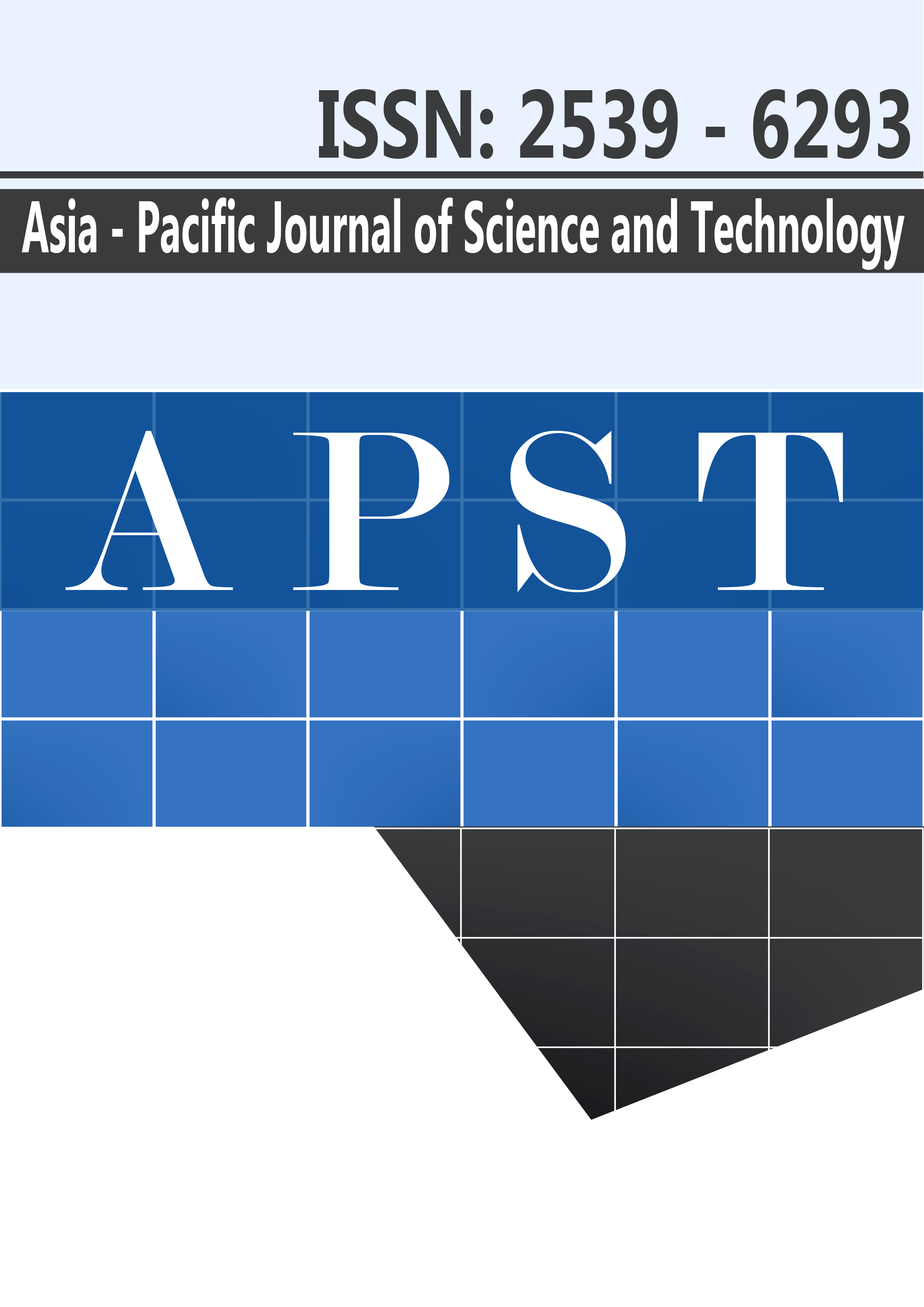Development of a mobile app for enhancing the performance of smallholder native chicken management and production
Main Article Content
Abstract
The purposes of this paper are: 1) to study farmers’ demographic information, farm characteristics, and mobile phone usage patterns; 2) to develop a mobile app that can comprehensively address the needs of native chicken farmers through dissemination of proper information; and 3) to collect and analyze completed satisfaction surveys by Thai native chicken (TNC) mobile app users. Data was collected from 50 farmers through the use of semi-structured interviews and statistically analyzed using measurements of frequency, percentage, and mean. Most of the farmers were male (84%), with an average age of about 52±9.40 years and with only a primary school education (40%). Most raised native chickens as a secondary career (92%) and had 5 years or less of farming experience (46%). Meanwhile, 34.06% raised chickens mainly for home consumption, 56% had medium-sized farms, and 90% reared in semi-intensive systems. Responses indicated that Android operating systems are more commonly in use than iPhone Operating System (iOS) (96% vs. 4%, respectively). The TNC mobile app is an Android-based app that serves as a tool for native chicken farmers in Thailand to improve their rearing methods and productivity. The key features of the app include information or guidance about Thai native chicken breeds, farm management, feed and feeding, and disease control. The users’ completed satisfaction surveys, from a total of 48 respondents, demonstrated that the overall satisfaction score was 4.15, signifying native chicken farmers’ satisfaction with the TNC mobile app in terms of functionality, aesthetics, and information quality.
Article Details
References
Wattanachant S, Benjakul S, Ledward DA. Composition, color and texture of Thai indigenous and broiler chicken muscles. Poultry Sci. 2004;83(1):123-128.
Heft-Neal S, Otte J, Pupphavessa W, Roland-Holst D, Sudsawasd S, Zilberman D. Supply chain auditing for poultry production in Thailand. Pro-poor Livestock Policy Initiative Research Report. [Internet]. 2008. [cited 2019 Jul 11]. Available from: https://bearecon.com/portfolio-data/fao-poultry-supply-chain/fao-poultry-supply-chain-report.pdf.
Jaturasitha S, Srikanchai T, Kreuzer M, Wicke M. Differences in carcass and meat characteristics between chicken indigenous to Northern Thailand (black-boned and Thai native) and imported extensive breeds (Bresse and Rhode Island Red). Poultry Sci. 2008;87(1):160-169.
Walter A, Finger R, Huber R, Buchmann N. Opinion: Smart farming is key to developing sustainable agriculture. PNAS. 2017;114(24):6148-6150.
Rose D, Chilvers J. Agriculture 4.0: responsible innovation in an era of smart farming. Front Sustain Food Syst. 2018;2:1-7.
Statisa. Number of smartphone users in Thailand from 2013 to 2022 [Internet]. 2019 [cited 2019 Jul 11]. Available from: https://www.statista.com/statistics/467191/forecast-of-smartphone-users-in-thailand/
Razaque A, Sallah M. The use of mobile phone among farmers for agriculture development. Int J Sci Res. 2013;2:95-98.
FAO. EMA-i: A mobile app for timely animal disease field reporting to enhance surveillance. Food and Agriculture Organization of the United Nations [Internet]. 2015. [cited 2019 Jul 13]. Available from: https://www.fao.org/3/a-i4853e.pdf
Tremblay M, Bennett T, Döpfer D. The DD check app for prevention and control of digital dermatitis in dairy herds. Prev Vet Med. 2016;132:1-3.
Costopoulos C, Ntaliani M, Karetsos S. Studying mobile apps for agriculture. IOSR J Mob Comput Appl. 2016;3:44-49.
Inwood SE, Dale VH. State of apps targeting management for sustainability of agricultural landscapes. A review. Agron Sustain Dev. 2019;39(1):1-15.
Saengwong S, Supakankul P, Buranawit K, Laenoi W, Koksantia C, Punyatong M. The development of android application for Thai native chicken farm management recording and warning system. J Agr Res Ext. 2018;35(Suppl. 2):911-919.
Sambrekar K, Rajpurohit VS. A Proposed model for mobile cloud computing in agriculture. Int J Sci Res Dev. 2014;2(7):433-436.
Statcounter. Mobile operating system market share Thailand Apr 2018-Apr 2019. [Internet]. 2019. [cited 2019 Jul 15]. Available from: https://gs.statcounter.com/os-market-share/mobile/thailand.
Bello-Bravo J, Olana GW, Pittendrigh BR. A pilot study using educational animations as a way to improve farmers’ agricultural practices and health around Adama, Ethiopia. Inf Technol Int Dev. 2015;11(3):23-37.
Shafipoor M, Sarayloo R, Shafipoor A. Infographic (information graphic); a tool for increasing the efficiency of teaching and learning processes. Int Acad J Innov Res. 2016;3(4):39-45.
Wyche S, Steinfield C, Cai T, Simiyu N, Othieno ME. Reflecting on video: Exploring the efficacy of video for teaching device literacy in rural Kenya. ICPS. 2016;1-10.
Bachhav NB. Information needs of the rural farmers: a study from Maharashtra, India: A survey. Libr Philos Pract. 2012;1-12.
Yusuf SF, Masika P, Ighodaro DI. Agricultural information needs of rural women farmers in Nkonkobe Municipality: The extension challenge. J Agric Sci. 2013;5(5):107-114.
Steinfield C, Wyche S, Cai T, Chiwasa H. The mobile divide revisited: mobile phone use by smallholder farmers in Malawi. ICPS. 2015:1-9.
Singh K, Varma AK. Agricultural information needs of farmers in select villages of Varanasi District: a case study. J Adv Libr Inform Sci. 2017;6(4):305-311.
Hamad MA, Eltahir ME, Ali AE, Hamdan AM. Efficiency of using smart-mobile phones in accessing agricultural information by smallholder farmers in North Kordofan–Sudan. [Internet]. 2018. [cited 2019 Jul 17]. Available from: https://ssrn.com/abstract=3240758.
Liu L, Zhang L, Ye P, Liu Q. Influence factors of satisfaction with mobile learning app: An empirical analysis of China. Int J Emerg Technol Learn. 2018;13(3):87-99.


